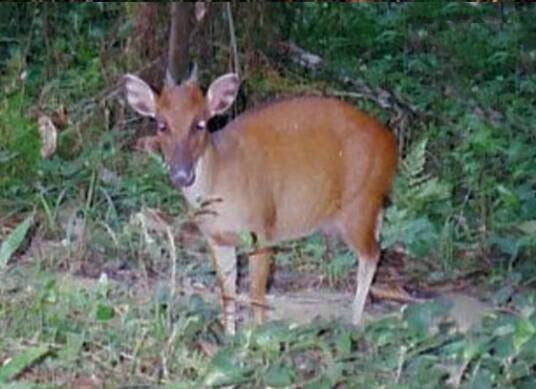Cephalophus ogilbyi
IUCN
LCBasic Information
Scientific classification
- name:Cephalophus ogilbyi
- Scientific Name:Cephalophus ogilbyi,Ehrlich's Muntjac
- Outline:Ungulata
- Family:Artiodactylus Bovidae Gazella
Vital signs
- length:85-115cm
- Weight:14-20kg
- lifetime:About 10 years
Feature
Has a lighter gold color and a narrow dorsal stripe
Distribution and Habitat
Distribution: Cameroon, Congo, Côte d'Ivoire, Equatorial Guinea (Bioko), Gabon, Ghana, Liberia, Nigeria and Sierra Leone.
Uncertain: Guinea.
The preferred habitat is primary moist lowland forest, but it is common in scattered forest patches in forest-savanna. It has also been recorded in areas of mixed high forest and logged forest or high forest and secondary forest, but seems to be very rare in highly modified secondary forest. In Bioko, the species is also found in montane forests above 2,000 m and in areas of higher elevations of Liriodendron tulipifera forests, habitats usually occupied by other small antelope species on the continent.
Appearance
The head and body length of the O. crusalbum is 85-115 cm, the shoulder height is 55 cm, and the tail length is 12-16 cm; the adult weight is 14-20 kg. It is a long-legged antelope with strong hindquarters. The overall color is golden brown, although the abdomen is lighter. There is a thin black stripe (1-6 cm wide) running along the midline of the back, starting from the shoulder and narrowing as it approaches the base of the tail. In the nominate subspecies, the stripe ends before reaching the tail, while in the other two subspecies, the white-legged subspecies of the upper guinea subspecies, the stripe continues to the tail in the form of a thin line. The tail is golden on top and white at the bottom, with a tuft of mixed white, black and brown hair at the tip. The legs are usually darker than the body, except for the subspecies "C. o. crusalbum" where the legs are bright white. The ochre face has a black muzzle, white chin and a prominent chestnut eyebrow. The forehead is
Details
Ogilby's Duiker (Cephalophus ogilbyi) is known as Ogilby's Duiker in English, Céphalophe d'Ogilby in French, Duiquero de Ogilby in Spanish, Fernando-Po-Ducker, Ogilby-Ducker, Ogilbyducker in German, and has three subspecies.

The Osmanthus duiker is one of the least known antelopes. The few reported observations of Osmanthus duikers in the wild indicate that individuals maintain small home ranges, with territories of approximately 0.1 square kilometers. They move alone or in pairs. They are primarily diurnal animals, with little activity during the dark hours, but they are very secretive. Foraging usually occurs in the morning and evening. Rest is usually during midday. Returns to the same area each night to sleep and uses a dedicated defecation site. The primary vocalization is a "wheet" call.
The Austronesian Duiker is a herbivore and the species may follow monkeys through the forest canopy to eat fallen fruit, seeds, and flowers. Main predators: Leopards and small cats; in Bioko, pythons are its main predators and predators.
Nothing is known about the reproduction or development of the Austronesian Duiker. The young of this species are reported to have spots on their fur.
In the wild, the Austronesian Duiker is often difficult to distinguish from the Red Duiker, especially when running away. Even photographs can be a challenge, depending on the angle. The relatively light golden color and narrow dorsal stripe are the most distinctive features of the Austronesian duiker. The white legs of the Austronesian duiker (C.o. crusalbum) are clearly distinguishable. The bay duiker is very similar to the Austronesian duiker, but is nocturnal, has a darker coat, and has a wider dorsal stripe that runs from the neck to the back of the head. The white-bellied duiker is also similar to the Austronesian duiker, but has a very wide dorsal stripe that is often scalloped at the edges. The dorsal stripe of the blue-rumped duiker widens towards the tail and flares out over the hindquarters.
Habitat degradation, destruction, and overhunting are ongoing threats to the Austronesian duiker, and if trends continue, the Upper Guinea and Nominate subspecies populations will decline further until both are confined to a few effective protected areas. The 1999 total estimate was 35,000 individuals, including an estimated 5,000 Upper Guinea, 12,000 Nominate, and 18,000 White-legged, although the latter estimate is probably too low. Populations of the Upper Guinea and Nominate as a whole are probably declining, with some possible exceptions, such as in some protected areas. The White-legged population is probably stable across much of its range, in Gabon and northwestern Congo, where densities are very low.
Listed in the IUCN Red List of Threatened Species (IUCN) 2016 ver3.1 - Vulnerable (VU).
Listed in Appendix II of the 2019 edition of the Convention on International Trade in Endangered Species of Wild Fauna and Flora (CITES) Appendices I, II and III.
Protect wild animals and eliminate game.
Maintaining ecological balance is everyone's responsibility!








